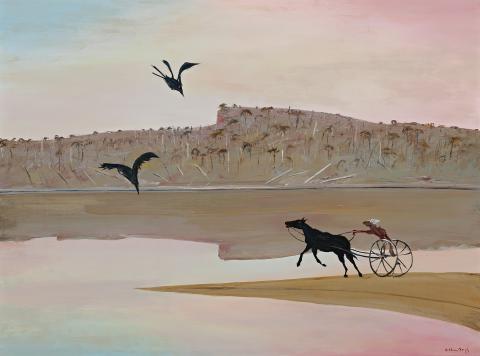THE SPIT, SHOALHAVEN, c.1976 - 77
ARTHUR BOYD
oil on composition board
91.0 x 122.0 cm
signed lower right: Arthur Boyd
Barry Stern Galleries, Sydney
Private collection, Sydney
Jinker on a Sandbank, 1976–77, in Hoff, U., The Art of Arthur Boyd, Andre Deutsche, London, 1986, pl. 149 (illus.)
It was the Shoalhaven’s wild and primitive nature, alien, primordial and untamed landscape which inspired Arthur Boyd to leave London after twenty-one years and return to live in Australia. And the light… It was hot, bright and brittle; the trees were dense and congested; the shadows deeper and more defined. And the river. The beauty of the river lined with willows and stately she-oaks, bush tracks, bottle brush, banksia, Christmas bush and wildflowers attracted him. Yet there was another side to this idyllic picture of nature; the great winding Shoalhaven River was an ever present unpredictable force waiting to explode.’1
From his initial visit to the area in the summer of 1971-72, Arthur Boyd was entranced by the Shoalhaven. So captivated with the wild beauty of the region, Boyd and his wife Yvonne purchased the property Riversdale in 1973 on the banks of the Shoalhaven River and then later acquired the nearby estate Bundanon six years later. Inspired by the surrounding environment Boyd would go on to relentlessly illustrate and explore the craggy rocks, the uncultivated terrain and the sensuous forms of the landscape. Although the Shoalhaven paintings are often set in a pure and bright light, there is an element of ‘darkness’ inherent to the Australian landscape through the instability of life, subject to mother nature. The River has the capacity to give life with one hand and destroy it with the other as the threat of drought and flooding is constant. It is this delicate balance between life and death perpetrated by the primordial river that fascinated Boyd.
In The Spit, Shoalhaven, Pulpit Rock rises in the background, a formidable and majestic presence set against the soft dusk sky, reflected in the disconcertingly still water. The calm beauty and tranquillity of the Shoalhaven River is juxtaposed against an incongruous mythic battle that is about to take place on the sandbank spit. A naked bestial figure rides an old fashioned jinker, pulled by a black horse that gallops across the spit heading straight for the river, perhaps in an effort to escape the plunging crows that are poised to attack or to meet them head on. Captured moments before the two entities collide, Boyd suspends the composition in trepidation and exhilaration. The demonic red eyes of the crows and the horse along with the strange figure riding the jinker, insinuate violence and turmoil on a psychological level and yet the unadulterated beauty of the landscape suggests an element of peace and calm.2 Taming his own wilderness, Boyd counteracts the darker allegorical figures with the serene setting of the Shoalhaven, in a harmonious depiction that touches on life and mortality and the wondrous power of nature.
CASSI YOUNG
1. McGrath, S., The Artist and the River: Arthur Boyd and the Shoalhaven, Bay Books, Sydney, 1982, p. 18
2. ibid., p. 65
